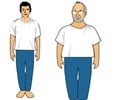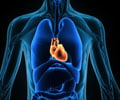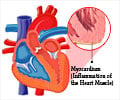Nutrition researchers at Washington University School of Medicine in St. Louis have denied that bodies shaped like pears or apples do not completely reveal a person's likelihood of developing high blood pressure or heart disease.
Their suggestion seems to contrasts the age-old thought that pear-shaped people, who carry weight in the thighs and backside, are at a lower risk for these problems than apple-shaped people, who carry fat in the abdomen.The researchers have based their proposition on two studies, which suggest that excess liver fat is the real key to insulin resistance, cholesterol abnormalities, and other problems that contribute to diabetes and cardiovascular disease.
In their report, they describe the storage of too much fat in the liver as nonalcoholic fatty liver disease.
"Since obesity is so much more common now, both in adults and in children, we are seeing a corresponding increase in the incidence of nonalcoholic fatty liver disease. That can lead to serious liver disorders such as cirrhosis in extreme cases, but more often it tends to have metabolic consequences," says senior investigator Dr. Samuel Klein, the Danforth Professor of Medicine and Nutritional Science
In their first study, the researchers studied obese adolescents. The subjects were divided into two groups: obese with excessive liver fat and those with no evidence of fatty liver disease. Both groups were matched by age, sex, body mass index, body fat percentage and degree of obesity.
Klein reveals that children with fatty liver disease were also found to have abnormalities in glucose and fat metabolism, including lower levels of HDL cholesterol, the so-called good cholesterol. He adds that kids without a fatty liver did not have markers of metabolic problems.
Advertisement
"Abdominal fat is not the best marker for risk. It appears liver fat is the real marker. Abdominal fat probably has been cited in the past because it tends to track so closely with liver fat. But if you look at people where the two don't correspond - with excess fat in the liver but not in the abdomen and vice versa - the only thing that consistently predicts metabolic derangements is fat in the liver," he says.
Advertisement
"Multiple organ systems become resistant to insulin in these adolescent children with fatty liver disease. The liver becomes resistant to insulin and muscle tissue does, too. This tells us fat in the liver is a marker for metabolic problems throughout the entire system," says Klein.
He deduces from the observations made during the two studies that children and adults with fatty liver disease should be targeted for intensive interventions.
He agrees that obese people who do not have fatty liver disease still should be encouraged to lose weight.
However, he insists that people with evidence of fatty liver are at particularly high risk for heart disease and diabetes, and that it is these people who need to be treated aggressively with therapies to help them lose weight because weight loss can make a big difference.
"Fatty liver disease is completely reversible. If you lose weight, you quickly eliminate fat in your liver. As little as two days of calorie restriction can improve the situation dramatically, and as fat in the liver is reduced, insulin sensitivity and metabolic problems improve," he says.
Source-ANI
SRM














